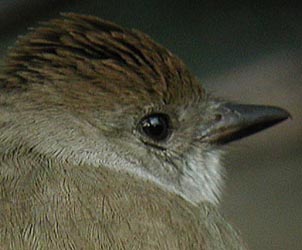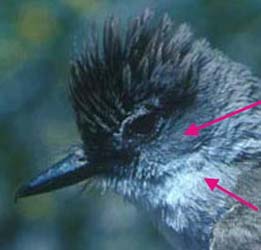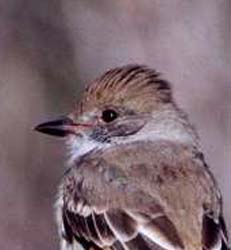A PHOTO DISCUSSION ON NUTTING'S
FLYCATCHER IDENTIFICATION:
Part 3: PLUMAGE
text © 2003 Don Roberson
all photographs are copyrighted © 2003
by the photographers cited; used here with permission
HEAD PATTERNS: Lanyon (1961) provided
analysis from over 700 birds of some consistent plumage difference — aside
from tail and secondary edge patterns — that separate specimens of Ash-throated
from Nutting's Flycatchers. Two of these features involve the head and
neck pattern. On Ash-throated, the "gray of the throat ... extends dorsally
as a prominent nuchal band, thus creating an area of contrast between the
browner crown and back" and "auriculars, forehead, and lores conspicuously
gray." In contrast, he states that in Nutting's "there is no prominent
nuchal band" and the "auriculars, forehead, and lores.... are brown." These
same points are repeated by Dittmann & Cardiff (2000) and Cardiff &
Dittmann (2002). Yet I have comments of some who consider these points
"worthless." Lanyon (1961) does caution that the characters are useful
"from December through February and are useless thereafter." This is because
wear changes and fades colors and contrasts. However, the Santa Cruz bird
we are discussing is a January individual of known age (first winter) and
therefore it seems prudent to consider these points.
| Some have used Kevin McKereghan's fine digiscope photos, like the one
immediately right, to conclude that the Santa Cruz bird had "gray" auriculars,
lores, and nape. The cheek and lore and side of neck color do look
a bit grayer than the brown crown, but the same can be said for the Orange
Co. Nutting's (far right © Larry Sansone). |
|
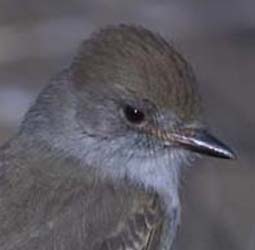 |
| Further, as discussed several times already, reliance on any one photo
— no matter how crisp — for purposes of color evaluation is unwise.
Tom Grey's digiscoped photos of the Santa Cruz bird (near left) show brown
cheeks, lore, and sides of neck. My own photo (far right) shows the auriculars
to be concolor with the crown and nape. |
|
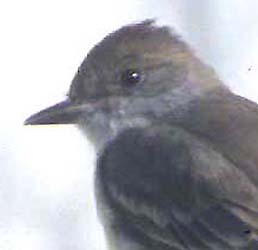 |
It is possible, indeed probable, that the focus should not be so much on
gray versus brown but, rather on issues of contrast between the auricular
areas and the gray throat and breast.
| On Ash-throated Flycatcher (both photos, right, © J.V. Remsen
& © D. Roberson) has very little contrast between the cheeck/auriculars
and the gray throat and breast (arrows on near right shot). The April bird
had far right not only shows the lack of contrast between cheek and throat,
but shows extensive gray around the eye and through the lores. |
|
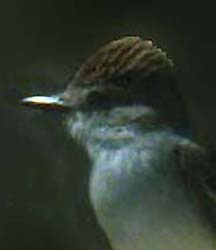 |
| On Nutting's Flycatcher, illustrated near right by the Orange Co. bird
(©D. Roberson), there is much more contrast between the cheek/auriculars
and throat. The far right photo (©D. Roberson) is a well-lit photo
(without flash) with some of these areas shown by arrows. You can determine
whether you think there is much contrast or not. Or you may conclude that
photographic evidence is unreliable on this point, and turn, instead to
field descriptions. All of those I have reviewed say that the bird had
brown auriculars and a gray throat. |
|
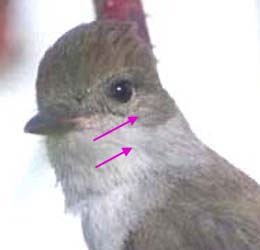 |
| There is also the question of the gray nuchal band mentioned by Lanyon
(1961). Ash-throated is said to have one while it is lacking in Nutting's.
Again, photos can be very poor for judging this. On the photo (near right)
of the Nutting's in Orange County (© Dan Lockshaw), a nuchal band
seems obvious. Someone relying on this shot would conclude that bird was
an Ash-throated. Other shots, like my own directly above, show the nape
was brown. The nape was also brown on the Santa Cruz bird (far right, this
row). That shot was taken just moments after the one directly above it,
and illustrates how the angle of the head affects this character in photos. |
|
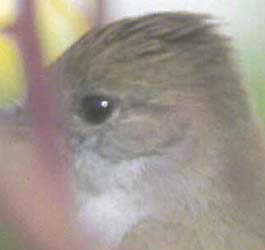 |
BELLY & BREAST: Lanyon (1961) says that
Ash-throated "is noticeably paler below. This is most evident at the junction
of the gray chest and yellow abdomen, at which point M. cinerascens
has an extremely pale, frequently white area separating the gray from the
yellow. In M. nuttingi, the yellow borders directly on the gray
chest, rendering a more contrasty sequence of colors."
Of all the points discussed on these pages, I find this one the most
subject to photographic variability. Whether the bird was in the shade
or the sun, and whether the photograph is over-or-under exposed, directly
affects these critical areas. For example, the photo of the Santa Cruz
bird (far right, two rows above) is in the sun and is over-exposed by at
least a half-stop. While it may show contrasts between colors, it can't
show the real density of colors. You can surf through the photos throughout
these pages and find examples of both over-exposed and under-exposed birds,
and it looks to me that most digiscoped photos are particularly "off" on
these characters, taking the "warm" or "cool" characteristics of the scope
involved. Photos in the sun (and that is most of them!) will inevitably
show the belly paler than in real life. Shade photos may be best for this
character.
What I can say, though, is that often the field impression of the Santa
Cruz bird was of a quite yellow-bellied bird. I think this was one of the
reasons it was initially identified as a possible Dusky-capped, and why
"Ash-throated" was not initially much of a concern for some of the initial
observers.
UPPERTAIL COVERTS: I'm not sure what it
means, but the uppertail coverts were edged rusty on the Santa Cruz bird,
and this feature was apparent in the field. This might be age-related,
but on the other hand, the uppertail coverts of both the southern California
and Arizona birds (presumably adults) were also described as edged with
rusty color. The uppertail coverts on Ash-throated Flycatcher are described
as "tinged rufous" in basic plumage (Cardiff & Dittmann 2002) but I
haven't seen this in the field. In comments on the Arizona bird in 1996,
Kimball Garrett discussed his review of specimens at the Natural History
Museum of Los Angeles County and, with the caveat that most Nutting's there
were taken in late winter while most Ash-throateds were collected in spring
and early summer, noted that the Nutting's had "rather rich brown (almost
rusty-tinged) uppertail coverts" while the Ash-throats had a "colder brown
(almost gray-brown)" color. It is possible that the rusty-colored uppertail
coverts of the Santa Cruz are important.
Other pages in this project are:
LITERATURE CITED:
-
Bowers, R.K., Jr., and J.B. Dunning, Jr. 1987. Nutting's Flycatcher (Myiarchus
nuttingi) from Arizona. Amer. Birds 41:5-10.
-
Cardiff, S.W., and D.L. Dittmann. 2000. Brown-crested Flycatcher (Myiarchus
tyrannulus) in The Birds of North America, No. 496 (A. Poole
and F. Gill, eds.). The Birds of North America, Inc., Philadelphia, PA.
-
Cardiff, S.W., and D.L. Dittmann. 2002. Ash-throated Flycatcher (Myiarchus
cinerascens) in The Birds of North America, No. 664 (A. Poole
and F. Gill, eds.). The Birds of North America, Inc., Philadelphia, PA.
-
Devillers, P. 1971. The alleged occurrence of Nutting's Flycatcher in Baja
California. Calif. Birds 2:140.
-
Dickerman, R.W., and A.R. Phillips. 1953. First United States record of
Myiarchus nuttingi. Condor 55:101-102.
-
Dittmann, D.L., and S.W. Cardiff. 2000. Let's take another look: Myiarchus
flycatchers. LOS News 193:3-10. Louisiana Ornithol. Society, Baton Rouge.
-
Howell, S.N.G., and S. Webb. 1994. Field identification of Myiarchus
flycatchers in Mexico. Cotinga 2:20-25.
-
Howell, S.N.G., and S. Webb. 1995. A Guide to the Birds of Mexico and northern
Central America. Oxford Univ. Press, New York.
-
Lanyon, W.E. 1961. Specific limits and distribution of Ash-throated and
Nutting flycatchers. Condor 63:421-449.
-
Lanyon, W.E. 1997. Great Crested Flycatcher (Myiarchus crinitus)
in
The Birds of North America, No. 300 (A. Poole and F. Gill, eds.). The Birds
of North America, Inc., Philadelphia, PA.
-
Murphy, W.L. 1982. The Ash-throated Flycatcher in the East: an overview.
Amer. Birds 36:241-247.
-
National Geographic Society. 1999. Field Guide to the Birds of North America,
3rd ed. Nat. Geogr. Soc., Washington, D.C.
-
Phillips, A.R., and W.E. Lanyon. 1970. Additional notes on the flycatchers
of eastern North America. Bird-Banding 41:190-197.
-
Pyle, P. 1997. Identification Guide to North American Birds, Part I: Columbidae
to Ploceidae. Slate Creek Press, Bolinas, CA.
-
Zimmerman, D.A. 1978. A probable Nutting's Flycatcher in southwestern New
Mexico. West. Birds 9:135-136.
TOP
GO TO MONTEREY
COUNTY PAGE
GO TO HOME PAGE
GO TO
IDENTIFICATION PAGE
GO TO BIRDING THE
WORLD PAGE
GO TO BIRD FAMILIES
OF THE WORLD
Page created 28-29 Jan 2003
